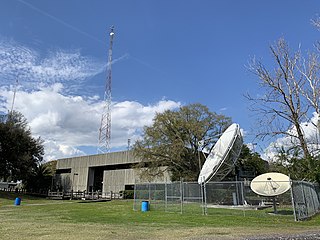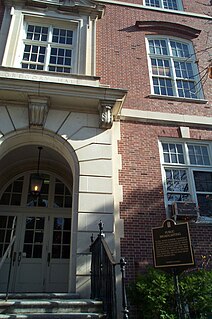FM broadcasting in the United States began in the 1930s at engineer and inventor Edwin Howard Armstrong's experimental station, W2XMN. The use of FM radio has been associated with higher sound quality in music radio.

Low-power broadcasting is broadcasting by a broadcast station at a low transmitter power output to a smaller service area than "full power" stations within the same region. It is often distinguished from "micropower broadcasting" and broadcast translators. LPAM, LPFM and LPTV are in various levels of use across the world, varying widely based on the laws and their enforcement.

The FM broadcast band is a range of radio frequencies used for FM broadcasting by radio stations. The range of frequencies used differs between different parts of the world. In Europe and Africa and in Australia and New Zealand, it spans from 87.5 to 108 megahertz (MHz) - also known as VHF Band II - while in the Americas it ranges from 88 to 108 MHz. The FM broadcast band in Japan uses 76 to 95 MHz, and in Brazil, 76 to 108 MHz. The International Radio and Television Organisation (OIRT) band in Eastern Europe is from 65.9 to 74.0 MHz, although these countries now primarily use the 87.5 to 108 MHz band, as in the case of Russia. Some other countries have already discontinued the OIRT band and have changed to the 87.5 to 108 MHz band.

Georgia Public Broadcasting (GPB) is a state network of PBS member television stations and NPR member radio stations serving the U.S. state of Georgia. It is operated by the Georgia Public Telecommunications Commission, an agency of the Georgia state government which holds the licenses for most of the PBS and NPR member stations licensed in the state. The broadcast signals of the nine television stations and 19 radio stations cover almost all of the state, as well as parts of Alabama, Florida, North Carolina, South Carolina and Tennessee.
In cable television, governments apply a must-carry regulation stating that locally licensed television stations must be carried on a cable provider's system.

WJCT is a non profit organization based in Jacksonville, Florida, which operates PBS member television station WJCT, NPR member radio station WJCT-FM, and WJCT Online.
WHYY-FM is a public FM radio station licensed to serve Philadelphia, Pennsylvania. Its broadcast tower is located in the city's Roxborough neighborhood at while its studios and offices are located on Independence Mall in Center City, Philadelphia. The station, owned by WHYY, Inc., is a charter member of National Public Radio (NPR) and contributes several programs to the national network.

WNYE is a non-commercial educational FM radio station licensed to New York City. The station is operated, along with WNYE-TV, by NYC Media, a division of the Mayor's Office of Media and Entertainment. Studios are located at the City University of New York's Graduate Center at 365 Fifth Avenue, and the transmitter is at the former Condé Nast Building.
KMTP-TV, virtual and digital UHF channel 32, is an independent non-commercial educational television station licensed to San Francisco, California, United States and serving the San Francisco Bay Area. The station is owned by the Minority Television Project. KMTP's studios are located on Woodside Way in San Mateo. Its transmitter, shared with KCNS, KTNC-TV and KEMO-TV, is located atop Sutro Tower in San Francisco.
KSUA is a student-run college radio station licensed to Fairbanks, Alaska, United States. Broadcasting from the University of Alaska Fairbanks (UAF) campus with 3,000 watts effective radiated power (ERP,) it serves the Alaska Interior area. When first on the air in 1984, it was one of a few commercially licensed college stations. Reorganized in 1993, KSUA now operates under the FCC non-commercial educational license public radio rules. KSUA has won statewide and national broadcasting awards.
Southern Oregon PBS is the PBS member network for most of the southwest region of the U.S. state of Oregon. It operates KSYS in Medford and full-time satellite KFTS in Klamath Falls. Studios are located on South Fir Street in downtown Medford. KSYS' transmitter is located on King Mountain, while KFTS' transmitter is atop Stukel Mountain.

WGPB FM 97.7 is a public radio station in Rome, Georgia. It is part of the Georgia Public Broadcasting radio network, a state network which in turn is a member of National Public Radio, Public Radio Exchange, and American Public Media. Unlike most stations on the GPB network, WGPB does not completely simulcast with the network. WGPB also produces its own programs. The studios are located at Georgia Highlands College's Heritage Hall campus in downtown Rome, from which locally produced programming originates. The station began broadcasting as WGPB at 5 AM on June 30, 2006.
KDYW, virtual channel 34, was a non-commercial educational television station licensed to Waco, Texas, United States. The station was owned by the Brazos Valley Broadcasting Foundation. As KCTF and KWBU-TV, it operated as a PBS member station for much of its on-air history, but was slated to be sold to Community Television Educators of Waco, Inc., a group associated with the Daystar Television Network, before surrendering its license.

An underwriting spot, known as sponsor credit in Japan, is an announcement made on public broadcasting outlets, especially in the United States, in exchange for funding. These spots usually mention the name of the sponsor, and can resemble traditional television advertisements in commercial broadcasting to a limited extent; however, under the terms of a public broadcaster's license from the Federal Communications Commission, such spots are prohibited from being promotional or making any sort of "call to action". In the U.S., these restrictions apply to any television or radio station licensed as a non-commercial educational (NCE) stations, and even for non-sponsoring companies and products. However, this is not the case in Japan, as these spots can be played on both public and private broadcasters and are typically played alongside traditional commercials and appear after a show's opening theme or after a preview of a next episode or appear during a scene of a show.
KUAC is a non-commercial FM radio station in Fairbanks, Alaska, broadcasting at 89.9 MHz. The station is operated by the University of Alaska Fairbanks. It debuted on October 2, 1962, originally at 104.9 MHz, as Alaska's first non-commercial radio station and second FM station.

A broadcast relay station, also known as a satellite station, relay transmitter, broadcast translator (U.S.), re-broadcaster (Canada), repeater or complementary station (Mexico), is a broadcast transmitter which repeats the signal of a radio or television station to an area not covered by the originating station. It expands the broadcast range of a television or radio station beyond the primary signal's original coverage or improves service in the original coverage area. The stations may be used to create a single-frequency network. They may also be used by an AM or FM radio station to establish a presence on the other band.

Intercollegiate Broadcasting System (IBS) is an organization with a membership of over one thousand non-profit, education-affiliated radio stations and webcasters. Founded in 1940, IBS is headquartered in New Windsor, New York, with a legal office in Washington, D.C. In addition to providing support for establishing and operating noncommercial radio and webcast operations, it frequently represents its members with FCC negotiations, copyright issues, and litigation.

WKEU-FM 88.9 is an FM radio station broadcasting a classic hits format. Its city of license is The Rock, Georgia, United States. The station is owned by Georgia Public Radio, Inc., and also features radio programming from ABC Radio. Having an original airdate in 1999, it is the sister station of WKEU AM 1450, in nearby Griffin, Georgia. The broadcast callsign was previously on 97.5 in Fayetteville, Georgia, also nearby.

Planning permission or developmental approval refers to the approval needed for construction or expansion, and sometimes for demolition, in some jurisdictions. It is usually given in the form of a building permit.

In the United States, other than a few direct services, public broadcasting is almost entirely decentralized and is not operated by the government, but does receive some government support.










